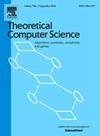Complexity of computing the anti-Ramsey numbers for paths
IF 0.9
4区 计算机科学
Q3 COMPUTER SCIENCE, THEORY & METHODS
引用次数: 0
Abstract
The anti-Ramsey numbers are a fundamental notion in graph theory, introduced in 1978, by Erdős, Simonovits and Sós. For given graphs G and H the anti-Ramsey number is defined to be the maximum number k such that there exists an assignment of k colors to the edges of G in which every copy of H in G has at least two edges with the same color.
Usually, combinatorists study extremal values of anti-Ramsey numbers for various classes of graphs. There are works on the computational complexity of the problem when H is a star. Along this line of research, we study the complexity of computing the anti-Ramsey number , where is a path of length k. First, we observe that when k is close to n (the number of vertices in G), the problem is hard; hence, the challenging part is the computational complexity of the problem when k is a fixed constant.
We provide a characterization of the problem for paths of constant length. Our first main contribution is to prove that computing for every integer is NP-hard. We obtain this by providing several structural properties of such coloring in graphs. We also study the exact complexity of the precolored version and show that there is no subexponential algorithm for the problem unless ETH fails for any fixed constant k.
计算路径的反拉姆齐数的复杂性
反拉姆齐数是图论中的一个基本概念,由Erdős、Simonovits和Sós在1978年提出。对于给定的图G和图H,反拉姆齐数ar(G,H)定义为k的最大值,使得G的边存在k种颜色的赋值,且G中H的每个副本至少有两条相同颜色的边。通常,组合学家研究各种图的反拉姆齐数的极值。当H是星型时,有很多关于计算复杂性的研究。沿着这条研究路线,我们研究了计算反拉姆齐数ar(G,Pk)的复杂性,其中Pk是长度为k的路径。首先,我们观察到当k接近n (G中的顶点数)时,问题很难;因此,具有挑战性的部分是当k为固定常数时问题的计算复杂性。我们给出了等长路径问题的一个表征。我们的第一个主要贡献是证明对于每个k≥3的整数计算ar(G,Pk)是np困难的。我们通过提供图中这种着色的几个结构性质得到了这一点。我们还研究了预着色版本的精确复杂性,并表明除非ETH对任何固定常数k失效,否则不存在亚指数算法。
本文章由计算机程序翻译,如有差异,请以英文原文为准。
求助全文
约1分钟内获得全文
求助全文
来源期刊

Theoretical Computer Science
工程技术-计算机:理论方法
CiteScore
2.60
自引率
18.20%
发文量
471
审稿时长
12.6 months
期刊介绍:
Theoretical Computer Science is mathematical and abstract in spirit, but it derives its motivation from practical and everyday computation. Its aim is to understand the nature of computation and, as a consequence of this understanding, provide more efficient methodologies. All papers introducing or studying mathematical, logic and formal concepts and methods are welcome, provided that their motivation is clearly drawn from the field of computing.
 求助内容:
求助内容: 应助结果提醒方式:
应助结果提醒方式:


